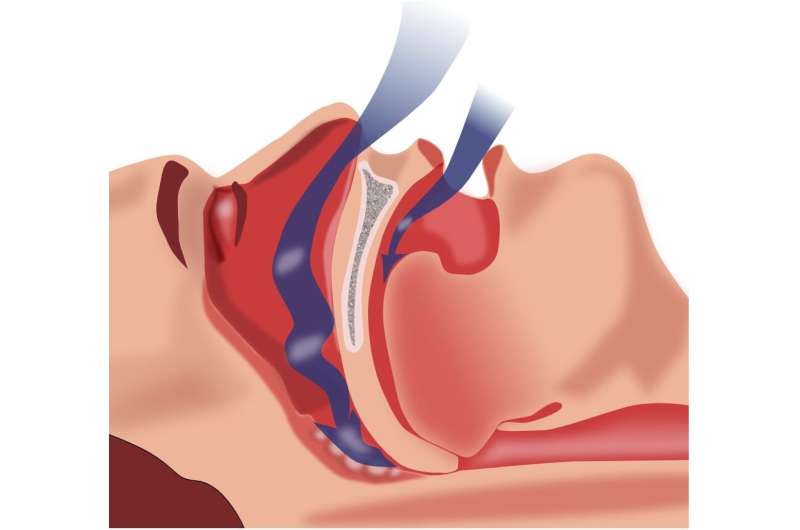This article has been reviewed according to Science X's editorial process and policies. Editors have highlighted the following attributes while ensuring the content's credibility:
fact-checked
trusted source
proofread
Data show significant prevalence of sleep apnea among cardio-oncology patients

Sleep apnea is prevalent among cardio-oncology patients who are at higher risk for congestive heart failure from cancer therapy, according to a new study being presented at the American College of Cardiology Advancing the Cardiovascular Care of the Oncology Patient course.
Sleep apnea is a disorder of altered breathing while asleep with two types, obstructive (OSA) or central (CSA). Both can be treated to alleviate symptoms and improve cardiovascular outcomes. This study pertains to obstructive sleep apnea.
A well-established screening tool for detecting sleep apnea is the STOP-BANG questionnaire utilizing eight questions using the acronym STOP-BANG (Snoring, Tiredness, Observed apnea, Pressure -elevated blood pressure, BMI, Age, Neck, Gender). It is scored based on yes/no answers with a range from 0–8. A score >3 shows a high sensitivity for detecting moderate and severe OSA.
Among heart failure patients in the general population, OSA maintains a 48–52% prevalence and is associated with heightened cardiovascular mortality and morbidity rates.
Previous studies have found that left ventricular ejection fraction (a measure used to determine how well the heart is pumping blood throughout the body) and Global Longitudinal LV Strain (GLS—a measure of how much the cell shrinks in size to generate the force to eject the blood out of the heart) can predict early cancer therapy related cardiomyopathy. OSA is also linked to LV dysfunction, congestive heart failure and abnormal LV-GLS.
While cardio-oncology patients have a higher risk for congestive heart failure from cancer therapy, there is no data on the prevalence of sleep apnea within this group.
The researchers used a sleep apnea questionnaire to assess the prevalence of sleep apnea among 296 general cardiology patients and 218 cardio-oncology patients. Data was collected on traditional risk factors, STOP-BANG scores, and history of sleep for both groups. Baseline echocardiogram left ventricular ejection fraction (LVEF) and GLS results were measured for the cardio-oncology population.
"Echocardiogram has evolved to be a useful tool to detect and therefore treat cardiomyopathy early in patients with sleep apnea and in the cardio-oncology population, so we also wanted to see if there are shared echo markers that identify patients who are at greater risk as they start their journey to treat their cancer," said Mini K. Das, MD, medical director of the cardio-oncology program at Baptist Health in Louisville, Kentucky and the study's primary author.
The incidence of sleep apnea was 54% in the general cardiology group and 39% in the cardio-oncology group. The prevalence of sleep apnea within the general cardiology group was similar to reported rates in patients with heart failure with reduced ejection fraction (HFrEF) or heart failure with preserved ejection fraction (HFpEF), where the rates were 52% with HFrEF and 48% with HFpEF. HFrEF and HFpEF are the two most common types of heart failure and indicate the heart is either too weak to pump properly (HFrEF) or too stiff to fill properly with blood (HFpEF).
According to the results of a questionnaire for sleep apnea using the STOP-BANG score, individuals with untreated sleep apnea and those who are at higher risk for sleep apnea have abnormal baseline left ventricular strain, which is a common echo parameter linked to adverse CV events.
"Identifying these individuals may allow early intervention in a risk factor clearly associated with heart failure now recognized to affect cancer therapy and survivorship," Das said.
The prevalence of sleep apnea in the cardio-oncology population was equal to or greater than other traditional risk factors that are currently used in risk factor profile algorithms. Even with a normal LVEF, the status and severity of sleep apnea were associated with abnormal LV strain. The results of this study show that LV GLS was more abnormal in patients with untreated sleep apnea or a high STOP-BANG score.
"Sleep apnea should be incorporated into current risk algorithms and a larger study is needed to evaluate the impact of sleep apnea in this high-risk population. We feel that sleep apnea assessment must be a part of routine risk assessment for patients undergoing cancer therapeutics," Das said.




















